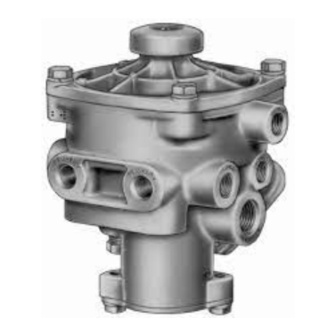BENDIX RE-4 RELAY EMERGENCY VALVE Manual - Halaman 2
Jelajahi secara online atau unduh pdf Manual untuk Unit Kontrol BENDIX RE-4 RELAY EMERGENCY VALVE. BENDIX RE-4 RELAY EMERGENCY VALVE 4 halaman. Relay emergency valve

DESCRIPTION
The relay emergency valve is normally used in trailer braking
systems. It is a dual function valve, combining the functions
of a relay valve and an emergency valve.
SERVICE LINE
EMERGENCY LINE
FIGURE 3 - TYPICAL RELAY-EMERGENCY VALVE
TRAILER PIPING
The relay function is identical to that of a relay valve, serving
the trailer air brake system as a remote controlled brake
valve. Control (service) pressure from the towing vehicle is
routed through the trailer service line and on to the relay
portion of the valve.
The emergency function of the valve automatically applies
full trailer reservoir air pressure to the trailer chambers
when the trailer supply pressure falls below a predetermined
minimum.
For ease of service the valve features an "insert" cartridge
consisting of the inlet/exhaust valve and emergency piston.
Removal of the insert can usually be accomplished without
line removal.
The valve may be flange or reservoir mounted, and identified,
convenient porting locations of delivery, service, emergency
(supply) and reservoir ports are provided. (Note: Reference
Figures 1 and 2, two configurations of the RE-4
shown). The older configuration (Figure 1) contained a total
of 13 ports. Check valve access was via a pipe plug on the
bottom of the valve. The newer and current configuration
contains 8 ports and check valve access is via a side cap
nut Interior components of both valves are identical.
OPERATION
INITIAL CHARGING
When a tractor is connected to a trailer and the service and
emergency lines are opened (via the tractor protection
system), the valve permits charging the trailer reservoir to
approximately the same air pressure as that of the tractor
reservoir. Under initial charge conditions, the valve applies
trailer service air chambers as the trailer emergency line is
2
RESERVOIR
RELAY
EMERGENCY
VALVE
BRAKE CHAMBER
SLACK
ADJUSTER
™
charged. This application is continued until the trailer supply
(emergency) line is charged to 60-65 psi, at which time the
application is automatically released. The trailer reservoir
continues to be charged to full operating pressure.
SERVICE APPLICATION
During normal service braking operation, the valve serves as
a relay valve, synchronizing tractor service (application) air
pressure with trailer service (application) air pressure as the
service foot brake valve on the tractor is operated. If the
tractor is equipped with a trailer hand control (TC) valve, the
DRAIN
trailer brakes can also be applied independently of the tractor
COCK
brakes.
EMERGENCY APPLICATION
(TRAILER AIR SYSTEM CHARGED TO NORMAL
OPERATING PRESSURE)
Venting the trailer supply line to atmosphere will cause the
emergency portion of the relay emergency valve to apply full
trailer reservoir pressure to the trailer air chambers.
If the trailer supply line pressure is reduced to approximately
20 psi due to leakage or conditions other than above, a
graduated trailer air chamber application will occur. The rate
of this brake application will depend upon the rate of pressure
loss in the supply line.
If the trailer is not equipped with parking actuators (such as
spring brakes), the trailer wheels should be blocked to
prevent trailer movement in the event reservoir pressure
would be depleted.
TO RELEASE AN EMERGENCY APPLICATION
Recharge trailer air system or:
A. For trailers equipped with standard brake chambers,
block wheels and drain trailer reservoir.
B. For trailers equipped with spring brake chambers, block
wheels and mechanically release spring brake chambers
via the mechanical release mechanism. (For specific
instructions, refer to manufacturer's service literature.)
valve are
PREVENTIVE MAINTENANCE
Important: Review the Bendix Warranty Policy before
performing any intrusive maintenance procedures. A warranty
may be voided if intrusive maintenance is performed during
the warranty period.
No two vehicles operate under identical conditions, as a
result, maintenance intervals may vary. Experience is a
valuable guide in determining the best maintenance interval
for air brake system components. At a minimum, the valve
should be inspected every 6 months or 1500 operating hours,
whichever comes first, for proper operation. Should the valve
not meet the elements of the operational tests noted in this
document, further investigation and service of the valve may
be required.
